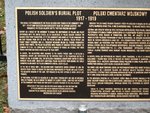Polish Independence Day, celebrated on November the 11th, marks the restoration of Poland's independence in 1918. After 123 years of partitions Poland reappeared on the map of Europe as a sovereign democratic state.
Polish Independence Day is strongly connected with general Jozef Pilsudski. After being feed from German prison Pilsudski came back to Poland on the morning of Sunday 10th November 1918. Only a handful of people new about his arrival and came to Warsaw's Vienna Station to welcome him. On November 11, 1918 the Germans and the Allies signed the agreement to end the First World War.
On the same day the Regency Council appointed Pilsudski Commander-in-Chief of Polish forces and asked him to form a Government. However on 13th November the Regency Council was dissolved and handed over to Pilsudski its "duties and responsibility toward the Polish people". Pilsudski was now the highest autority of Poland and would remain so for 98 days until 20th February 1919 when he handed power to the Sejm.
Polish Independence Day is strongly connected with general Jozef Pilsudski. After being feed from German prison Pilsudski came back to Poland on the morning of Sunday 10th November 1918. Only a handful of people new about his arrival and came to Warsaw's Vienna Station to welcome him. On November 11, 1918 the Germans and the Allies signed the agreement to end the First World War.
On the same day the Regency Council appointed Pilsudski Commander-in-Chief of Polish forces and asked him to form a Government. However on 13th November the Regency Council was dissolved and handed over to Pilsudski its "duties and responsibility toward the Polish people". Pilsudski was now the highest autority of Poland and would remain so for 98 days until 20th February 1919 when he handed power to the Sejm.

 Poland!
Poland!

